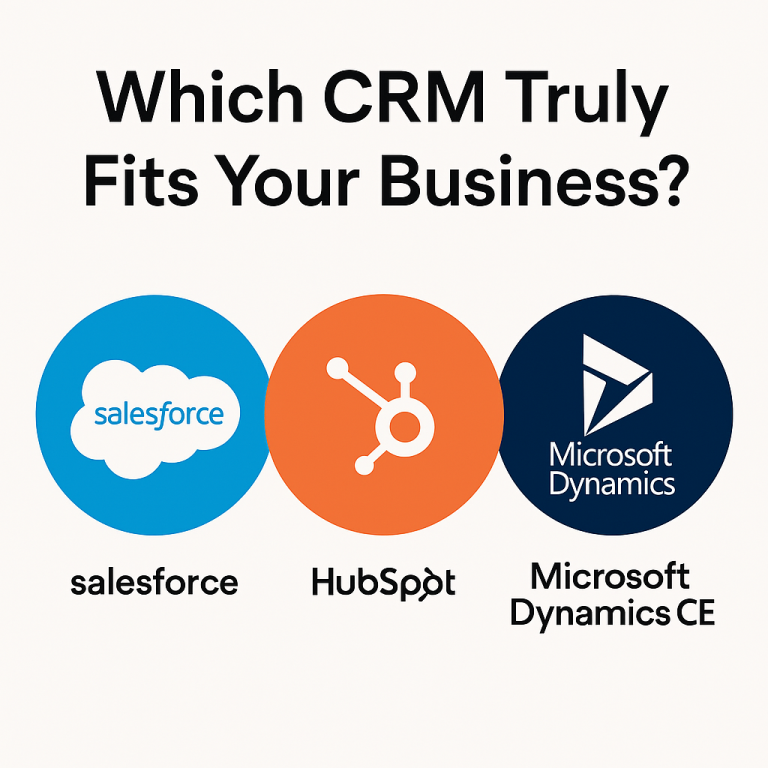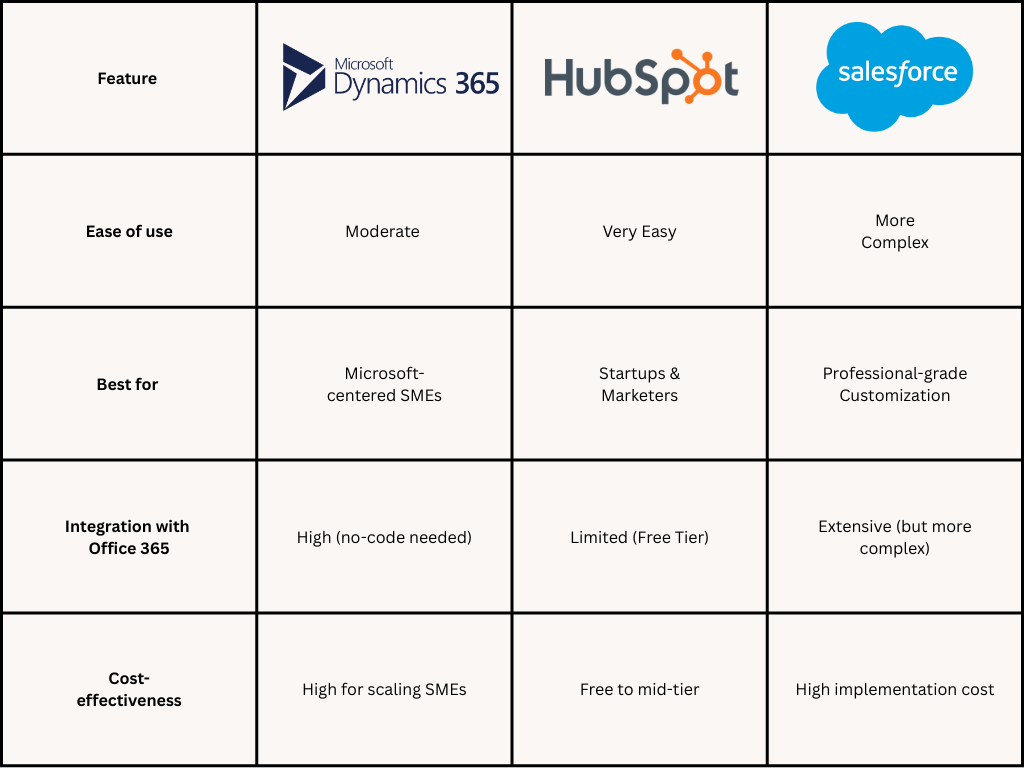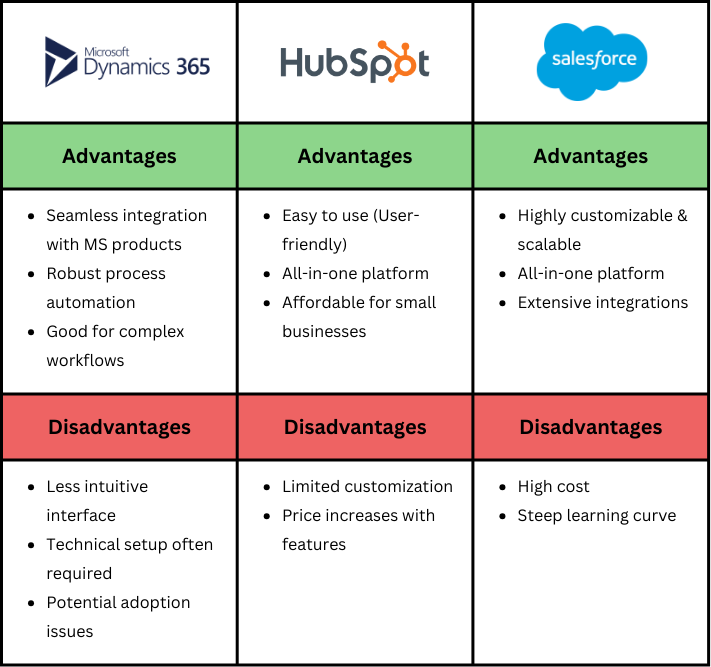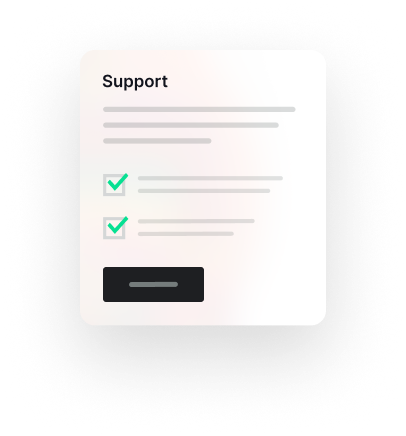Salesforce vs. HubSpot vs. Microsoft Dynamics CE: Which CRM Truly Fits Your Business?

Choosing the right CRM (Customer Relationship Management) platform is more than a tech decision. It’s a strategic inflection point. The right CRM helps unify teams, empower customer-facing roles, and drive sustainable growth. The wrong one? It becomes an expensive contact database no one wants to use.
The stakes are high. According to Gartner, CRM software represents the largest software market in the world, projected to reach over $80 billion by 2025. Yet despite this massive investment, up to 70% of CRM implementations fail to deliver expected ROI (Forrester). Why? Not because the tools are broken, but because they’re mismatched to the business, misused by the team, or misaligned with strategy.
Three of the most dominant CRM platforms on the market today, Salesforce, HubSpot, and Microsoft Dynamics CE, each offer unique advantages. But they also come with limitations. Understanding where each excels, and what each demands from your organization, can make the difference between success and disappointment.
Common Reasons CRM Projects Fail
Before comparing platforms, let’s unpack the four key reasons why CRM systems often underperform:
- Poor alignment with real workflows
CRMs configured around generic templates don’t reflect how your team actually works. - Low user adoption
Complex interfaces and unclear value lead to disengagement. - Weak integration
When the CRM doesn’t connect with marketing, finance, or operations, it stays siloed. - Feature overload without enablement
A robust tool without proper training, support, and evolution becomes digital clutter.
A successful CRM isn’t just a platform. It’s a living system. That requires attention to four core pillars:
The Four Pillars of CRM Success:
- Technical enablement: Is the platform configured and integrated to support real workflows?
- Business steering: Is the CRM helping drive strategic goals and decision-making?
- Innovation: Is it evolving with new use cases, automation, and insights?
- User acceptance: Do teams actually use it, and find value in it?
With that in mind, let’s break down what each platform offers.
HubSpot CRM: Simplicity and Speed for Growing Teams
HubSpot has grown rapidly in popularity, with over 194,000 customers globally as of 2024. Its appeal lies in its simplicity and speed, particularly for businesses where marketing is the tip of the spear.
Strengths:
- User-friendly interface with fast onboarding, ideal for non-technical teams.
- All-in-one platform for marketing, sales, and customer service, reducing tool sprawl.
- Free and lower-cost entry points allow startups and small teams to get started easily.
- Fast time-to-value. Setup can take days, not months.
Limitations:
- Customization ceiling: As businesses scale, HubSpot can become restrictive in adapting to complex workflows.
- Price escalation: The base CRM is free, but advanced features (like granular permissions, custom objects, or reporting) quickly drive up costs.
- Integration challenges: While HubSpot offers native integrations, larger or legacy systems may be harder to connect.
Best for: Small to mid-sized businesses, especially those that are marketing-led and value simplicity over deep customization.
Salesforce CRM: The Most Professional, Deeply Customizable Solution
With over 150,000 customers and a dominant market share among professional-grade CRMs, Salesforce has become synonymous with high-end, customizable customer engagement. Its real strength is scale and depth of customization.
Strengths:
- Highly configurable with custom workflows, automation, and AI features (Einstein).
- Vast AppExchange ecosystem with thousands of integrations and industry-specific solutions.
- Offers a professional-grade feature set that scales from agile SMEs to multi-region teams, ideal for any company that needs depth and flexibility.
- Strong focus on data and reporting, with highly customizable dashboards and forecasting tools.
Limitations:
- Higher total cost of ownership: Licensing, consulting, and development can be significant.
- Steep learning curve: Configuration and user training are essential to avoid low adoption.
- Implementation time: A full-feature rollout can take several months.
Interesting stat: According to Nucleus Research, Salesforce delivers an average return of $8.71 for every dollar spent, but only when properly implemented and aligned with business needs.
Best for: Any business, especially ambitious SMEs that need a professional-grade CRM with deep customization, advanced automation, and the ecosystem to support growth.
Microsoft Dynamics CE: Seamless Integration for Operational Complexity
Often overshadowed by its flashier competitors, Microsoft Dynamics Customer Engagement (CE) quietly serves a large installed base, especially among organizations already using Microsoft tools. It shines when CRM needs to talk to ERP, finance, or operations.
Strengths:
- Deep integration with Microsoft 365, Teams, Power BI, and Azure enables seamless data sharing.
- Particularly strong in process automation using Power Platform (Power Automate, Power Apps).
- More suited for structured, rules-based workflows, such as field service, manufacturing, or professional services.
- Solid reporting through Power BI, with enterprise-grade security and data models.
Limitations:
- User interface is less polished and intuitive than HubSpot or Salesforce.
- Technical configuration often required, especially for integrations and custom workflows.
- Adoption challenges if teams aren’t already used to the Microsoft ecosystem.
Best for: Organizations using Microsoft tech stack, particularly those with operational or ERP complexity (e.g., manufacturers, service providers, government).
Analytics & Innovation: The Hidden Levers of CRM ROI
A CRM isn’t just a contact database. It’s a decision-making engine, if it’s set up right.
- Salesforce leads in predictive analytics, offering AI-powered forecasts, opportunity scoring, and deal insights via Einstein.
- Dynamics CE stands out when paired with Power BI, enabling interactive dashboards that span departments.
- HubSpot offers a clean, accessible view of marketing and sales data, but is more limited in flexibility and depth.
Yet, the impact of analytics doesn’t come from features alone. It depends on:
- Data quality and hygiene
- Well-defined KPIs
- User-friendly dashboards tied to action
- A feedback loop between what’s tracked and how teams behave
Companies that invest in reporting as a strategic asset, not just a byproduct, are those that outperform peers by 23% in revenue growth (Harvard Business Review, 2022).

Final Thoughts: Choosing the Right CRM Means Knowing Yourself
The “best” CRM isn’t the one with the most features. It’s the one that aligns with how your business works and where it’s going.
- HubSpot is ideal for teams that want to move fast and keep things simple, especially in marketing-led businesses.
- Salesforce is the go-to for organizations that need to scale complexity and deeply tailor the system.
- Dynamics CE is the right fit for process-heavy businesses already embedded in Microsoft’s ecosystem.
But regardless of platform, CRM success hinges on what comes next. The quality of implementation, the thoughtfulness of design, the ability to evolve, and whether people actually use it to make better decisions.
If any of these sound like weak spots, that’s not a software problem. It’s a strategic opportunity.
Need Help Choosing or Implementing a CRM?
Whether you’re starting from scratch or optimizing an existing system, your CRM can be a growth catalyst, if designed right.
Or contact us directly:
Marc Andre Lein | +31 (0)6 40 98 12 85 | info@impulssum-digital.com | Visit our website



